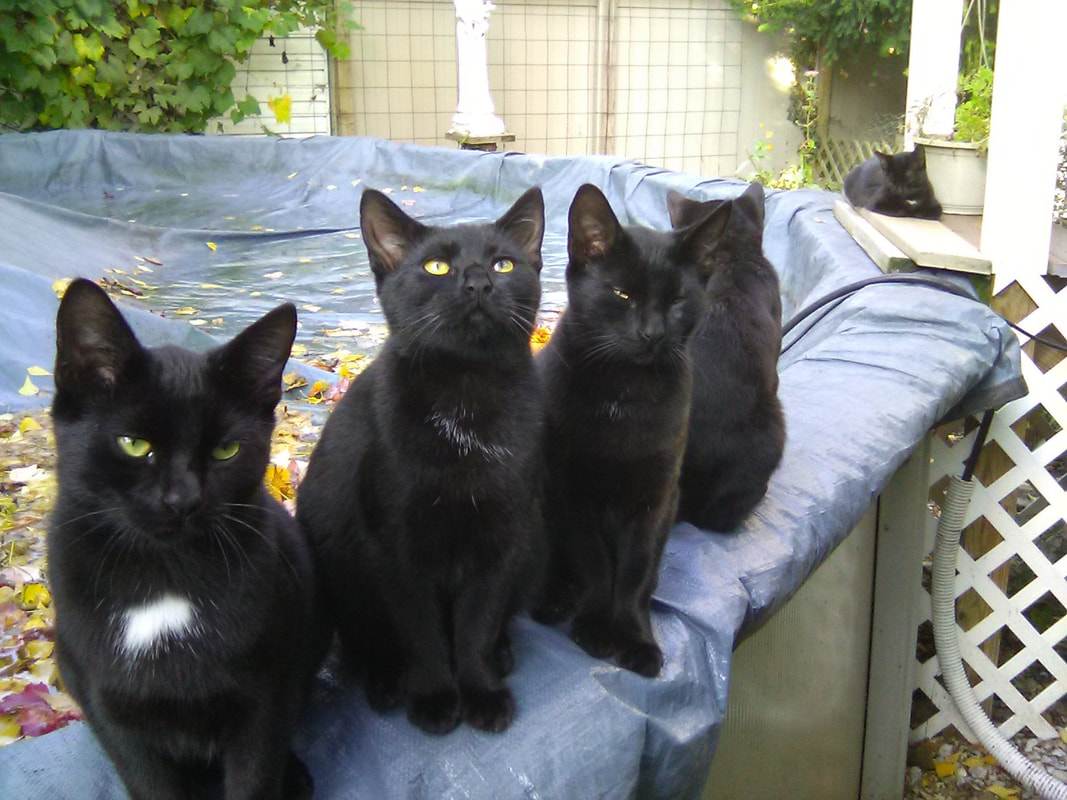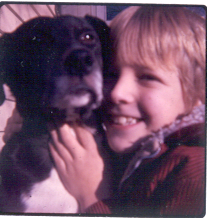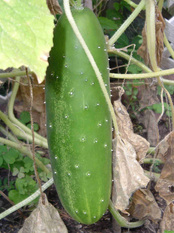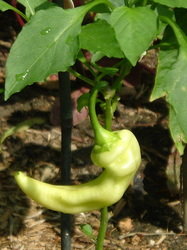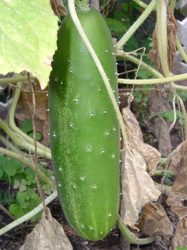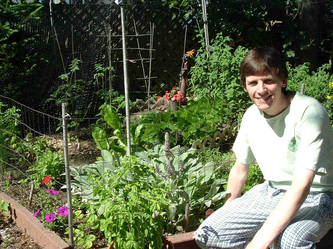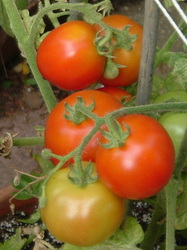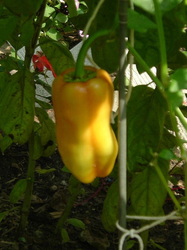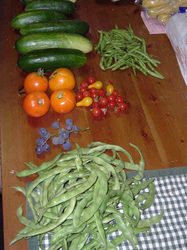Pictures say a thousand words. Yet since animals cannot speak, we need to add an exponential to that expression. How often have we seen a stray cat, for example, rummaging through a garbage can in hopes of finding its only "meal" for the week? In our domesticated culture, where sight and sound far outweigh care and compassion, we tend to adopt a cat or a dog depending on our needs, not theirs.
I often encounter would-be adopters at a local pet store's adoption facility. Here you have roughly twenty individually caged cats in 2x2x2 cages being displayed for all to see. I make a point to spend a good deal of time with them whenever I visit the store, meowing and caressing them to give some sort of love to an otherwise sad and depressed crew.
Enter the dragon. I would estimate a good 85% of the entering would-be adopters, as I can attest to while standing there and hearing them talk, look only for the best looking cat of the lot. "No, he's too runty looking, how about that one?" or "I don't want a gray speckled cat, that black one is nicer." Unbelievably, it appears our modern-day culture has grossly misaligned the very essence of many of its processes, and animal adoption is certainly one of them.
First of all, let us give some credit to these people for making an effort to adopt, albeit misaligned. The fact still remains, animals need people to care for them, otherwise they would most assuredly die on the street or be euthanized by the shelter (what?). Any adoption, therefore, is an unseen miracle in my opinion. But the troubling fact remains too that we are placing our own desires ahead of the animal's and labeling the process "Adoption." Instead of picking the prize of the litter, should we not be choosing the animal most in need? The true nature of this issue is supposed to be all about philanthropic benevolence. But where is the heart? I will one day catch up with those would-be so-called "adopters" and confront them with my calculated reply to their foolish talk by rhetorically asking "What if your own child came out runty, would you still want him?"
Hold it! We're not finished. Did you take notice at that 'what' remark just above? Shelters are, once again, "supposed" to be essentially that, shelters. However, let the truth be known. "Fido, you've got a 3-month lease here, after that you're history." If an animal in a shelter fails to be adopted after three months, that animal is typically euthanized. This is a terrible, terrible tragedy. And how ironic, once again a misaligned process to its very nature. With the exception of a few remote animal shelters who have "No Kill" policies, what your typical neighborhood puppy and kitty shelter is doing is three quarters merciful, and one quarter economic. Yes, money is always a factor isn't it. The $75 adoption fee you pay for your new pet may indeed be a "nice buy", but there's a financial component of this whole transaction. The shelter shells out the upfront cost for the pet's upkeep and contractual veterinarian care. That cost typically runs about...$75. Coincidence? Not really, animal shelters are bound by cost limitations just as the rest of the world is.
Does this then justify a three-month term limit on a homeless animal's life? To what degree of animal welfare do animal "welfare" shelters aspire to? Clearly there are financial obstacles in managing a shelter, but what kind of mature intellect puts death as a solution? It is said that humans utilize only a small degree of their minds. If only those purporting to care for the homeless would exercise their brain power more, pooling their efforts in finding lifelong solutions for homeless animals. Animal food is cheap, water is free, and physical space isn't an issue for our smaller stature friends. Let's grow up and show a little backboned effort and appreciation in choosing life for animals, who like children, depend on us for everything.
Yet are puppies and kittens the full extent of our "crowning achievement" at philanthropic benevolence? Where do we draw the line in determining what animals we should save? Would a rhinoceros be excluded? How about a goat? Further still, how about those beasts of burden we mass bread, send out to pasture, and then cut their throats so we can satisfy our appetites? Considering our supposed intelligence and resourcefulness in sustainability, we are, as the broken record continues to play, clearly misaligned in this process. True, our systematic slaughtering process of cows, chickens, pigs, lambs, and even fish solves the problem of sustainability. But where, we should ask, is the human element of compassionate ingenuity? Apparently those two words are at a tug of war in today's mindset. To be compassionate requires sacrifice, which fewer and fewer people want to do. Ingenuity, of course, is always welcomed. In our fast food, IM, and 4G world, we have lost appreciation for the "fine bottle of vintage wine". Instead, we want our meals instantaneously and with ease.
And at who's expense? The innocent and helpless cow grazing in the sunlit pasture. Compassionate ingenuity asks us to brainstorm sustainable means of food intake while simultaneously expressing humanitarianism throughout the process. See the below section "How about a Not dog" for some of that brainstorming.
But let's get back to that cow grazing under the sun. "Oh come on, it's not a pet, it's got no feelings" is the typical attitude of the street corner Joe. Yet our "Slaughterhouse 5" example (cows, chickens, pigs, lambs, and fish) are all living, breathing creatures, merely several notches in intellect below 'homo sapiens'. Has a rabbit ever told anyone how it feels? Maybe that's why we think it has no feelings. Then how do we know it has the potential to "feel". Well, let's try looking at a creature's simple reactions to stimuli. The classic example of an electric shock in animal experimentation proves the point at hand. If used, the 'guinea pig' host reacts by moving away from the source of the pain. This is not an unconscious motor reflex reaction like peristalsis, but one that is fully awake and intentional. The fact that the animal intentionally avoids the pain source indicates that it experienced an adverse reaction and knows to stay away. In short, it felt something. Now, multiply that experience with other types of stimuli and the collection thus would constitute what are known as "feelings". For what are our own feelings but collections of experiences we have classified into categories. Sadness, happiness, pain, and joy to name a few. These are all labels for reactions to a particular occurrence. As we have just pointed out, simply because a creature doesn't meow or bark does not mean that it has no feelings. Therefore, it can logically be concluded that all creatures have feelings.
The butterfly zone. The title came to mind as I was thinking about the content of this webpage. It comes from a live exhibition once featured at the Museum of Natural History in New York which I visited. Thousands of butterflies with multi-colored wingspans fluttered about under a huge enclosure of tropical plants. As the visitor walked the winding path through the tranquil environment, different species of the insect floated by, some perched on plants, either resting or feeding...or wondering who we were! You couldn't help but marvel at these tiny creatures and think, 'Is their astonishingly beautiful life so meaningless, just a short-lived wonderment of a life form catching our eyes for an instant?' The Indian spiritual sect known as Jainism might provide some insight into an otherwise careless attitude we hold for these and other creatures which we hardly ever ponder. Of course, it is obvious that there are multiple levels of appreciation for multiple levels of living creatures. We rate humans of course at the top, giving the most attention to. Arguably, next would come our pets, followed to a lesser degree by our pet mammals, reptiles, rodents, and continuing down the ladder to, perhaps our backyard bee hive or ant colony. It is evident that we consider the lower rung creatures, such as a wasp, as totally meaningless and having absolutely no merit or justification to live or die. The mosquito biting our arm is automatically swatted dead without any thought whatsoever. Yes, I admit that I would probably also automatically swat it dead. But the question remains, should there be a line drawn in deciding what degree of life form we hold as worthy or unworthy of living? There should not.
Save the Animals
I often encounter would-be adopters at a local pet store's adoption facility. Here you have roughly twenty individually caged cats in 2x2x2 cages being displayed for all to see. I make a point to spend a good deal of time with them whenever I visit the store, meowing and caressing them to give some sort of love to an otherwise sad and depressed crew.
Enter the dragon. I would estimate a good 85% of the entering would-be adopters, as I can attest to while standing there and hearing them talk, look only for the best looking cat of the lot. "No, he's too runty looking, how about that one?" or "I don't want a gray speckled cat, that black one is nicer." Unbelievably, it appears our modern-day culture has grossly misaligned the very essence of many of its processes, and animal adoption is certainly one of them.
First of all, let us give some credit to these people for making an effort to adopt, albeit misaligned. The fact still remains, animals need people to care for them, otherwise they would most assuredly die on the street or be euthanized by the shelter (what?). Any adoption, therefore, is an unseen miracle in my opinion. But the troubling fact remains too that we are placing our own desires ahead of the animal's and labeling the process "Adoption." Instead of picking the prize of the litter, should we not be choosing the animal most in need? The true nature of this issue is supposed to be all about philanthropic benevolence. But where is the heart? I will one day catch up with those would-be so-called "adopters" and confront them with my calculated reply to their foolish talk by rhetorically asking "What if your own child came out runty, would you still want him?"
Hold it! We're not finished. Did you take notice at that 'what' remark just above? Shelters are, once again, "supposed" to be essentially that, shelters. However, let the truth be known. "Fido, you've got a 3-month lease here, after that you're history." If an animal in a shelter fails to be adopted after three months, that animal is typically euthanized. This is a terrible, terrible tragedy. And how ironic, once again a misaligned process to its very nature. With the exception of a few remote animal shelters who have "No Kill" policies, what your typical neighborhood puppy and kitty shelter is doing is three quarters merciful, and one quarter economic. Yes, money is always a factor isn't it. The $75 adoption fee you pay for your new pet may indeed be a "nice buy", but there's a financial component of this whole transaction. The shelter shells out the upfront cost for the pet's upkeep and contractual veterinarian care. That cost typically runs about...$75. Coincidence? Not really, animal shelters are bound by cost limitations just as the rest of the world is.
Does this then justify a three-month term limit on a homeless animal's life? To what degree of animal welfare do animal "welfare" shelters aspire to? Clearly there are financial obstacles in managing a shelter, but what kind of mature intellect puts death as a solution? It is said that humans utilize only a small degree of their minds. If only those purporting to care for the homeless would exercise their brain power more, pooling their efforts in finding lifelong solutions for homeless animals. Animal food is cheap, water is free, and physical space isn't an issue for our smaller stature friends. Let's grow up and show a little backboned effort and appreciation in choosing life for animals, who like children, depend on us for everything.
Yet are puppies and kittens the full extent of our "crowning achievement" at philanthropic benevolence? Where do we draw the line in determining what animals we should save? Would a rhinoceros be excluded? How about a goat? Further still, how about those beasts of burden we mass bread, send out to pasture, and then cut their throats so we can satisfy our appetites? Considering our supposed intelligence and resourcefulness in sustainability, we are, as the broken record continues to play, clearly misaligned in this process. True, our systematic slaughtering process of cows, chickens, pigs, lambs, and even fish solves the problem of sustainability. But where, we should ask, is the human element of compassionate ingenuity? Apparently those two words are at a tug of war in today's mindset. To be compassionate requires sacrifice, which fewer and fewer people want to do. Ingenuity, of course, is always welcomed. In our fast food, IM, and 4G world, we have lost appreciation for the "fine bottle of vintage wine". Instead, we want our meals instantaneously and with ease.
And at who's expense? The innocent and helpless cow grazing in the sunlit pasture. Compassionate ingenuity asks us to brainstorm sustainable means of food intake while simultaneously expressing humanitarianism throughout the process. See the below section "How about a Not dog" for some of that brainstorming.
But let's get back to that cow grazing under the sun. "Oh come on, it's not a pet, it's got no feelings" is the typical attitude of the street corner Joe. Yet our "Slaughterhouse 5" example (cows, chickens, pigs, lambs, and fish) are all living, breathing creatures, merely several notches in intellect below 'homo sapiens'. Has a rabbit ever told anyone how it feels? Maybe that's why we think it has no feelings. Then how do we know it has the potential to "feel". Well, let's try looking at a creature's simple reactions to stimuli. The classic example of an electric shock in animal experimentation proves the point at hand. If used, the 'guinea pig' host reacts by moving away from the source of the pain. This is not an unconscious motor reflex reaction like peristalsis, but one that is fully awake and intentional. The fact that the animal intentionally avoids the pain source indicates that it experienced an adverse reaction and knows to stay away. In short, it felt something. Now, multiply that experience with other types of stimuli and the collection thus would constitute what are known as "feelings". For what are our own feelings but collections of experiences we have classified into categories. Sadness, happiness, pain, and joy to name a few. These are all labels for reactions to a particular occurrence. As we have just pointed out, simply because a creature doesn't meow or bark does not mean that it has no feelings. Therefore, it can logically be concluded that all creatures have feelings.
The butterfly zone. The title came to mind as I was thinking about the content of this webpage. It comes from a live exhibition once featured at the Museum of Natural History in New York which I visited. Thousands of butterflies with multi-colored wingspans fluttered about under a huge enclosure of tropical plants. As the visitor walked the winding path through the tranquil environment, different species of the insect floated by, some perched on plants, either resting or feeding...or wondering who we were! You couldn't help but marvel at these tiny creatures and think, 'Is their astonishingly beautiful life so meaningless, just a short-lived wonderment of a life form catching our eyes for an instant?' The Indian spiritual sect known as Jainism might provide some insight into an otherwise careless attitude we hold for these and other creatures which we hardly ever ponder. Of course, it is obvious that there are multiple levels of appreciation for multiple levels of living creatures. We rate humans of course at the top, giving the most attention to. Arguably, next would come our pets, followed to a lesser degree by our pet mammals, reptiles, rodents, and continuing down the ladder to, perhaps our backyard bee hive or ant colony. It is evident that we consider the lower rung creatures, such as a wasp, as totally meaningless and having absolutely no merit or justification to live or die. The mosquito biting our arm is automatically swatted dead without any thought whatsoever. Yes, I admit that I would probably also automatically swat it dead. But the question remains, should there be a line drawn in deciding what degree of life form we hold as worthy or unworthy of living? There should not.
Save the Animals
How about a Not Dog?
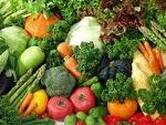
In addition to my editing role for this website, I thought to finally offer an article in response to much ado dealing with my peculiarly unique eating habits. You see, for the past 18 years, I have been a vegetarian. That's right, no meat! I would describe my diet as steady vegetarian, however as opposed to the strict vegan who takes the added step of rejecting any kind of animal produced food such as milk, cheese, and eggs, I still eat those products. I am also gradually eliminating fish.
I began my adventure into the diet almost twenty years ago when I received a book called The Egg Project, by Gary Null. After first skimming through the pages and 'digesting' some of its content, I found myself continually picking up the book and delving further into what Null, a renowned health expert, had written. Can you picture me sitting by a Kingsford lit barbeque with burgers and dogs cooking up, maybe a can of Coke in hand, reading this book on the perils of meat eating? Well, that's more or less what happened.
In 1990, I went cold turkey, ceasing all meat intake, basically due to what this book was talking about. There's not enough room on this webpage to even summarize what the book entailed, all the research, study groups, experimentation, both traditional and holistic medicinal facts, and statistics. Needless to say, as you might have guessed, it was an eye opener. Unfortunately, cold turkey may work for some things like cigarette smoking, but it's not a good idea for dieting. By the spring of 1990, having ceased meat consumption for a few months, I developed pneumonia which lasted 3 months. Coughed up all kinds of white phlegm and had a running fever! Bad idea. As my body was basically in shock from the absence of meat, what I should have done was gradually decrease my meat intake over a year's time, while increasing my soy intake, which is basically the primary ingredient for the vegetarian's protein requirement.
The main reason I opted for vegetarianism is simply due to learning what meat contains. For example, the typical chicken cutlet contains ingredients such as beta-blockers and tetracycline. Farmers add these drugs to their livestock's food supply to combat such germs as salmonella. Of course there is debate as to whether long term side-effects occur. However, it's interesting to learn that countries eating natural meats (those w/out added drugs), have fewer old age illnesses.
The method for obtaining red meat (beef) has increasingly seen negative comment as you probably have heard. Studies have shown that slaughterhouses using the method of 'knife cutting across throat' simultaneously causes the animal's natural defense reaction to fill its meaty muscles with testosterone. That hormone thus ends up on the dinner plate. However, there has been progress to combat this dilemma, as calmer ways have been introduced to euthanize.
But am I going to convert back to a carnivorous diet in light of these hopeful new methods? No. I have turned more ethical I guess. As an animal lover, personally I find it difficult to show affection to a pet cat or pet dog, while at the same time eating a fellow animal. Or for that matter, wearing a fellow animal...I'm also a leather alternative person.
Getting back to diet, my typical dinner consists of a soy product, steamed veggies, and some pasta. Sunshine Burgers, made of crushed sunflower seeds, are a favorite, along with Okara Burgers (made from the hull of the soy bean), and Tempeh (a condensed soy product). I also drink soy milk for breakfast. However, my favorite dinner meal is Italian sausage with sun-dried tomato and basil...and made entirely out of soy. I also enjoy hot dogs, well, more precisely, they're called Not Dogs, another soy-based goodie, and having no sodium nitrates like real hot dogs do (bad news for the intestines). It's amazing that many of these products taste exactly like the real thing. You'd never know the difference. I was thrilled that some friends all went vegetarian for lunch one day and sampled my Italian sausage. Though a few faces went queasy upon first bite, I was thrilled they stepped up to the plate. Just consider me their new mentor, on the food front.
Health experts have debated whether a vegetarian diet can equate nutritiously to a carnivorous one. The arguments for both are good. Unfortunately vegetarianism is often adopted by younger adults who want to be trendy. However, they fail to research exactly what it entails and label themselves 'vegetarian' merely for its appeal, thus becoming malnourished to an extent, though they often don't realize it. The key to selecting alternatives to meat is to first read-up on the subject, second to sit down and figure out roughly what types of veggie foods provide similar nutrition to meats, and third to gradually incorporate those foods into your diet. For example, I supplement my diet with plenty of fruits, nuts, and seeds. In actuality, simply because I rely on these items, I am in effect getting better nourishment than the average person because that person would most likely be filling themselves with unhealthy snacks and would never feel hungry enough to reach for a handful of raw sunflower seeds, let's say. Additionally, I do not eat refined processed sugar, except for the trace levels found in breads for example. I prefer the natural sugars found in fruits and the like. I think reading ingredient labels on the food we buy is a key point to make. I try to select organic produce as much as possible. After all, who wants to eat an apple with Azinphos Methyl pesticide waxed onto it? Or eat a corn muffin with FD&C Yellow #5 as its principle ingredient? You'd be surprised to learn that, dollar for dollar, buying health food doesn't cost that much more money than regular food. But how much is your health worth? I also take vitamin/mineral supplements and unlike most people taking antacids for heartburn...I actually take acid, that is, Beta-Pepsin hydrochloric acid digestive aid, made by the supplement giant Solgar, and designed for better nutrient absorption.
I don't know, to me it's a matter of common sense. On the meat issue, any reasonably educated person would have to at least limit their intake of meats after reading up on the topic. Meat certainly has its benefits, I agree, however there are serious pitfalls. Perhaps a diet of eating all foods in moderation would fit most people's routine, and somewhere along the adventure, they might get hooked on a hot dog, oh excuse me, I mean a Not Dog. ~
I began my adventure into the diet almost twenty years ago when I received a book called The Egg Project, by Gary Null. After first skimming through the pages and 'digesting' some of its content, I found myself continually picking up the book and delving further into what Null, a renowned health expert, had written. Can you picture me sitting by a Kingsford lit barbeque with burgers and dogs cooking up, maybe a can of Coke in hand, reading this book on the perils of meat eating? Well, that's more or less what happened.
In 1990, I went cold turkey, ceasing all meat intake, basically due to what this book was talking about. There's not enough room on this webpage to even summarize what the book entailed, all the research, study groups, experimentation, both traditional and holistic medicinal facts, and statistics. Needless to say, as you might have guessed, it was an eye opener. Unfortunately, cold turkey may work for some things like cigarette smoking, but it's not a good idea for dieting. By the spring of 1990, having ceased meat consumption for a few months, I developed pneumonia which lasted 3 months. Coughed up all kinds of white phlegm and had a running fever! Bad idea. As my body was basically in shock from the absence of meat, what I should have done was gradually decrease my meat intake over a year's time, while increasing my soy intake, which is basically the primary ingredient for the vegetarian's protein requirement.
The main reason I opted for vegetarianism is simply due to learning what meat contains. For example, the typical chicken cutlet contains ingredients such as beta-blockers and tetracycline. Farmers add these drugs to their livestock's food supply to combat such germs as salmonella. Of course there is debate as to whether long term side-effects occur. However, it's interesting to learn that countries eating natural meats (those w/out added drugs), have fewer old age illnesses.
The method for obtaining red meat (beef) has increasingly seen negative comment as you probably have heard. Studies have shown that slaughterhouses using the method of 'knife cutting across throat' simultaneously causes the animal's natural defense reaction to fill its meaty muscles with testosterone. That hormone thus ends up on the dinner plate. However, there has been progress to combat this dilemma, as calmer ways have been introduced to euthanize.
But am I going to convert back to a carnivorous diet in light of these hopeful new methods? No. I have turned more ethical I guess. As an animal lover, personally I find it difficult to show affection to a pet cat or pet dog, while at the same time eating a fellow animal. Or for that matter, wearing a fellow animal...I'm also a leather alternative person.
Getting back to diet, my typical dinner consists of a soy product, steamed veggies, and some pasta. Sunshine Burgers, made of crushed sunflower seeds, are a favorite, along with Okara Burgers (made from the hull of the soy bean), and Tempeh (a condensed soy product). I also drink soy milk for breakfast. However, my favorite dinner meal is Italian sausage with sun-dried tomato and basil...and made entirely out of soy. I also enjoy hot dogs, well, more precisely, they're called Not Dogs, another soy-based goodie, and having no sodium nitrates like real hot dogs do (bad news for the intestines). It's amazing that many of these products taste exactly like the real thing. You'd never know the difference. I was thrilled that some friends all went vegetarian for lunch one day and sampled my Italian sausage. Though a few faces went queasy upon first bite, I was thrilled they stepped up to the plate. Just consider me their new mentor, on the food front.
Health experts have debated whether a vegetarian diet can equate nutritiously to a carnivorous one. The arguments for both are good. Unfortunately vegetarianism is often adopted by younger adults who want to be trendy. However, they fail to research exactly what it entails and label themselves 'vegetarian' merely for its appeal, thus becoming malnourished to an extent, though they often don't realize it. The key to selecting alternatives to meat is to first read-up on the subject, second to sit down and figure out roughly what types of veggie foods provide similar nutrition to meats, and third to gradually incorporate those foods into your diet. For example, I supplement my diet with plenty of fruits, nuts, and seeds. In actuality, simply because I rely on these items, I am in effect getting better nourishment than the average person because that person would most likely be filling themselves with unhealthy snacks and would never feel hungry enough to reach for a handful of raw sunflower seeds, let's say. Additionally, I do not eat refined processed sugar, except for the trace levels found in breads for example. I prefer the natural sugars found in fruits and the like. I think reading ingredient labels on the food we buy is a key point to make. I try to select organic produce as much as possible. After all, who wants to eat an apple with Azinphos Methyl pesticide waxed onto it? Or eat a corn muffin with FD&C Yellow #5 as its principle ingredient? You'd be surprised to learn that, dollar for dollar, buying health food doesn't cost that much more money than regular food. But how much is your health worth? I also take vitamin/mineral supplements and unlike most people taking antacids for heartburn...I actually take acid, that is, Beta-Pepsin hydrochloric acid digestive aid, made by the supplement giant Solgar, and designed for better nutrient absorption.
I don't know, to me it's a matter of common sense. On the meat issue, any reasonably educated person would have to at least limit their intake of meats after reading up on the topic. Meat certainly has its benefits, I agree, however there are serious pitfalls. Perhaps a diet of eating all foods in moderation would fit most people's routine, and somewhere along the adventure, they might get hooked on a hot dog, oh excuse me, I mean a Not Dog. ~
Anti-Leather Campaign

Did you ever stop to think about just how many pairs of leather footwear sit in our closets or on our feet? Not to mention the countless leather coats, belts, gloves, and wallets we own. Leather is everywhere. With the same auto-thoughtlessness we give to drinking a glass of water, we automatically, instinctively, and ignorantly give to purchasing a pair of shoes. Its convenience is our main attraction, followed closely by its obvious durability. Yet how often does it cross our minds that what we are spending our hard-earned money on directly supports the killing of animals? Cowhide, for example, is the principle ingredient in a typical leather shoe. Coupled with the fact that we are hesitant to shake our carnivorous diet, the average cow is in for a one-two punch, murdered to have its flesh eaten and its skin made into clothing. And, why is this so? Because we haven't yet matured into a responsible, conscientious society. Our ignorant and totally unintellectual demand fuels the supply of leather goods. It's very simple: you buy a leather belt from a vendor, the supply goes down, the vendor requests more from his source, and another helpless animal then loses its life for the next customer. And does this process ever cross our minds? No. We like our "end products" regardless of how they are created. As long as they are wrapped up pretty, pleasing to the touch, and make us appear to fit in with the culture.
Occasionally we hear of supporters to GreenPeace and PETA and label them "radical", simply because we have never given contemplative thought to what they are saying. Ironically however, we absolutely love our pets, don't we. Perish the thought that any harm should befall them. Like a knight in shining armor, we would take up our swords in a flash at the first iota of threat to our small friends. Yet, for the fully functioning person, the question needs to be asked: How can one caress their pet with genuine love while simultaneously chow down on a hamburger or slip on a pair of leather sandals? Is our love for animals truly love or..."love"? Perhaps we actually do not love our pets, but instead love "loving" our pets. Where then is the depth of heart if we select what we choose to love? Would not authentic love for animals require a complete attitude without any hypocritical practices? Yet, we continue to buy our leather shoes, coats, belts, gloves, and wallets and sleep peacefully at night in ignorance.
...Yet, we don't have to be so ignorant. With a small amount of effort, our intentional demand for leather goods can quickly cease to exist, or at least be curtailed. Following the same logic as in the section "How about a Not Dog", just as our diet can be sustained (and actually improved) via vegetarianism, so too can our apparel be sustained via leather alternatives. In fact, ecologically speaking, it is actually more logical to use natural sources of clothing such as cotton. The cotton plant's function is to produce cotton which the plant actually wants to have picked as part of its cycle. The plant produces seeds, as all plants do, to ensure its replication (not reproduction). That is a very important factor. You see, animals do not replicate, they depend on reproduction as the natural way of order. Killing an animal is unnatural therefore and ecologically wrong. Plants, on the other hand, demand that they get picked so as to grow all over again from their seed, produce, get picked, and then grow all over again.
Neanderthal Man never knew this, and, it appears even with education, modern man is following suit! Quite simply put, if you step outside of yourself and take a glance, you will realize that a carnivorous diet and wearing animal skin is absurdly barbaric. The Homo Sapiens species (Man) simply does not need to eat meat or wear skin in order to survive and be protected. Our intestines were not even designed for meat consumption, being rather short as opposed to carnivorous wild animals who have very long intestinal tracts which are designed to store meat for several days. And we certainly don't need to wear leather or fur in order to protect ourselves from the elements. But, we have "intellectually" circumvented that fact by nicely and neatly preparing animal flesh for easy consumption and grooming a mink to make a cape that some woman can wear to the opera. Our ignorance and stupidity have been retained so much so that our teeth have evolved into a more refined version of Cro Magnon man's, which resembled your local shark's teeth. Quite frankly, we fail in many ways to utilize the capacity of our brainpower. Look how long it takes us to understand. We are still waging war upon ourselves, even though we want peace. We are still polluting the air with carcinogens, even though we hate cancer. We are still depleting the earth of its oil, even though the sun is sitting up there free for the taking. And, we are still eating meat.
GreenCoast explains a nice variety of leather alternative wear. Or, for a touch of flare, choose the gear chosen by the Indiana Jones of Staten Island and his Real Live Relic Hunter team, Whispering Smith.
Occasionally we hear of supporters to GreenPeace and PETA and label them "radical", simply because we have never given contemplative thought to what they are saying. Ironically however, we absolutely love our pets, don't we. Perish the thought that any harm should befall them. Like a knight in shining armor, we would take up our swords in a flash at the first iota of threat to our small friends. Yet, for the fully functioning person, the question needs to be asked: How can one caress their pet with genuine love while simultaneously chow down on a hamburger or slip on a pair of leather sandals? Is our love for animals truly love or..."love"? Perhaps we actually do not love our pets, but instead love "loving" our pets. Where then is the depth of heart if we select what we choose to love? Would not authentic love for animals require a complete attitude without any hypocritical practices? Yet, we continue to buy our leather shoes, coats, belts, gloves, and wallets and sleep peacefully at night in ignorance.
...Yet, we don't have to be so ignorant. With a small amount of effort, our intentional demand for leather goods can quickly cease to exist, or at least be curtailed. Following the same logic as in the section "How about a Not Dog", just as our diet can be sustained (and actually improved) via vegetarianism, so too can our apparel be sustained via leather alternatives. In fact, ecologically speaking, it is actually more logical to use natural sources of clothing such as cotton. The cotton plant's function is to produce cotton which the plant actually wants to have picked as part of its cycle. The plant produces seeds, as all plants do, to ensure its replication (not reproduction). That is a very important factor. You see, animals do not replicate, they depend on reproduction as the natural way of order. Killing an animal is unnatural therefore and ecologically wrong. Plants, on the other hand, demand that they get picked so as to grow all over again from their seed, produce, get picked, and then grow all over again.
Neanderthal Man never knew this, and, it appears even with education, modern man is following suit! Quite simply put, if you step outside of yourself and take a glance, you will realize that a carnivorous diet and wearing animal skin is absurdly barbaric. The Homo Sapiens species (Man) simply does not need to eat meat or wear skin in order to survive and be protected. Our intestines were not even designed for meat consumption, being rather short as opposed to carnivorous wild animals who have very long intestinal tracts which are designed to store meat for several days. And we certainly don't need to wear leather or fur in order to protect ourselves from the elements. But, we have "intellectually" circumvented that fact by nicely and neatly preparing animal flesh for easy consumption and grooming a mink to make a cape that some woman can wear to the opera. Our ignorance and stupidity have been retained so much so that our teeth have evolved into a more refined version of Cro Magnon man's, which resembled your local shark's teeth. Quite frankly, we fail in many ways to utilize the capacity of our brainpower. Look how long it takes us to understand. We are still waging war upon ourselves, even though we want peace. We are still polluting the air with carcinogens, even though we hate cancer. We are still depleting the earth of its oil, even though the sun is sitting up there free for the taking. And, we are still eating meat.
GreenCoast explains a nice variety of leather alternative wear. Or, for a touch of flare, choose the gear chosen by the Indiana Jones of Staten Island and his Real Live Relic Hunter team, Whispering Smith.
Perfume, Laundry Detergent, and even Chocolate Bars?

Do your research. A 10 minute check on your favorite everyday household item might reveal the hidden, horrific truth.
...Yet there is hope. Here is a list of companies that DO NOT test on animals. Make the switch today.
